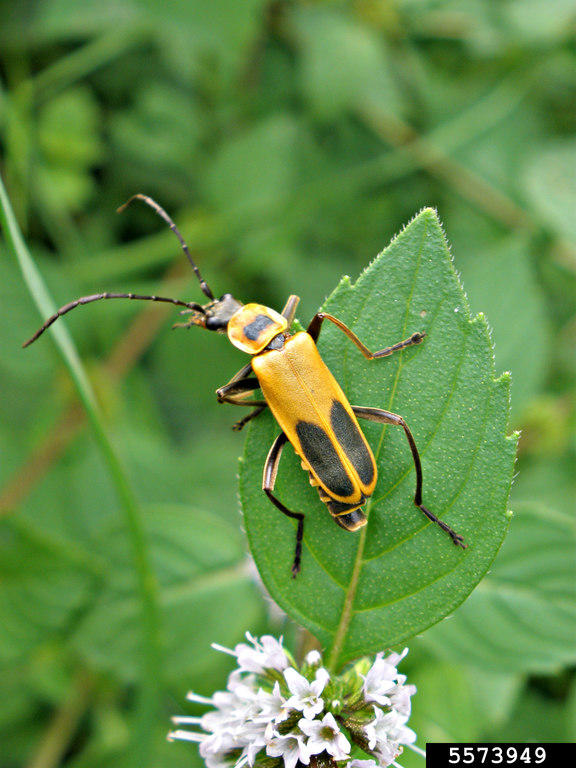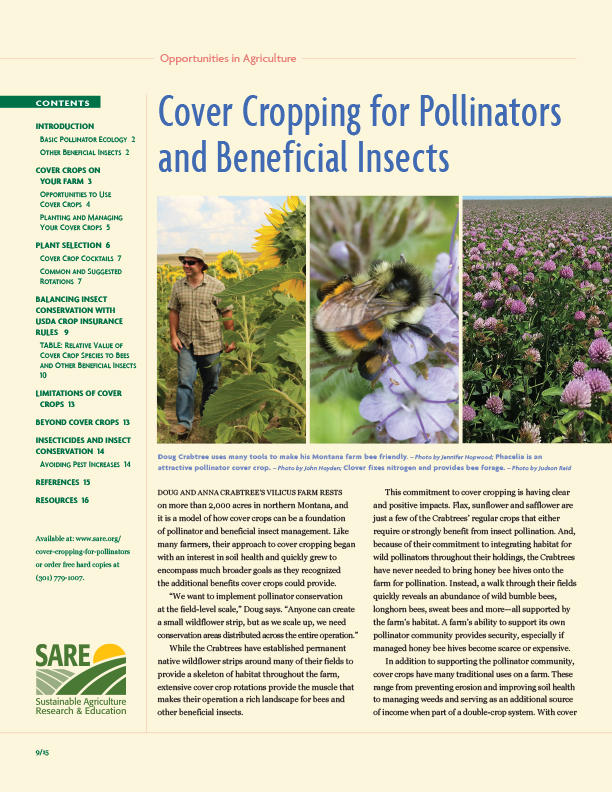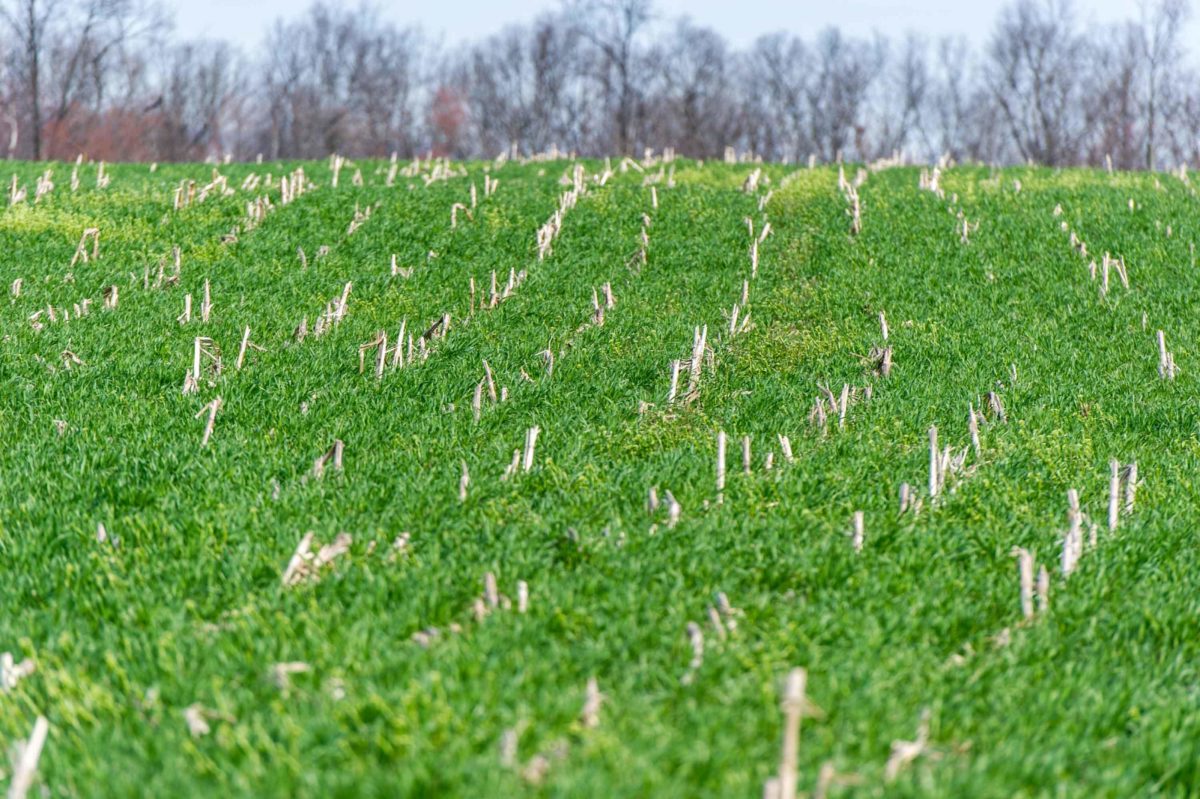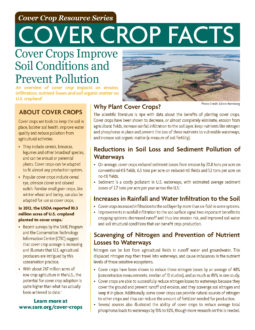An overview of how cover crops provide habitat for insects and other invertebrates that contribute to pest control.
Download this fact sheet (PDF). This fact sheet is part of the Ecosystem Services from Cover Crops fact sheet series.

What Are Natural Enemies?
Natural enemies are beneficial invertebrates that consume or otherwise help control crop pests. They can be insects, arthropods, nematodes or other types of invertebrates. The world of invertebrates is incredibly diverse, offering many ecological ways to keep pests in check.
- Lady beetles are some of the most effective predators of crop pests such as aphids and moth eggs. They are a good example of highly mobile, generalist predators that eat many different types of pest.
- Ground beetles are also generalist predators and highly mobile, but stick to the soil surface where they are important predators of caterpillars, slugs and corn rootworms.
- Parasitoid wasps have some of nature’s most fascinating life cycles. These tiny wasps lay eggs on or inside their hosts. The eggs hatch into larvae that devour the host. Parasitoid wasps typically specialize on only a few species of host insects. They are commonly purchased and released on farms to provide a boost in natural enemies.
- Spiders, although not technically insects, are usually beneficial predators. Strong spider populations can help control pests like armyworms.1
Don’t forget about the life beneath your feet. The soil harbors many invertebrates, and just as with the aboveground insects we can readily see, there are beneficial invertebrates belowground.
- Nematodes may be microscopic, but they are very numerous in the soil and can have a large impact on pest insects and plants. Some nematodes are pests or disease vectors, but many are either harmless or very beneficial to plants. Some nematodes help make nutrients available to plants while others attack root-feeding insects and harmful bacteria. Cover crops can decrease populations of detrimental nematodes.2
How Do Cover Crops Help Natural Enemies?
Cover crops help provide natural enemies with food and shelter year-round, boosting their numbers in cash crops and potentially reducing pest pressures. Although often mentioned in orchard settings, natural enemies can also work in traditional Midwestern row crops. In one South Dakota study, corn fields following a cereal rye cover crop supported more predatory insects and suffered less corn rootworm damage than fields with no cover crops.3
- Cover crops can sustain natural enemy populations when cash crops are not growing and when crop pests may not be present. Cover crops attract alternative prey that natural enemies can feed on until cash crops are established.
- When the cover crop is terminated, some of the predators will move to the cash crop, consuming pests and limiting their damage.
- Cover crops provide resources other than prey for natural enemies. Most natural enemies depend on plants for nectar, pollen, overwintering cover or habitat for eggs and larvae.

Cover Cropping for Pollinators and Beneficial Insects
This 16-page bulletin will help you use cover crops to encourage populations of pollinators and beneficial insects on your farm while you address your other resource concerns.
Download File (840.79 kB) | Online Text Version
Free print copies: Visit Cover Cropping for Pollinators and Beneficial Insects.
Managing Cover Crops for Natural Enemies
Cover crops are managed with multiple goals in mind; there are some practices to consider when trying to manage for natural enemies.
- Mixtures of cover crops support more diverse communities of natural enemies. Natural enemy diversity suppresses more types of potential pests more effectively.
- Allowing cover crops to flower will support the greatest abundance of natural enemies, but a diversity of non-flowering plants still provides valuable alternative prey and habitat for natural enemies.
- Insecticides kill natural enemies as well as pest insects and should not be applied to cover crops unless they are to be harvested.
Cover Crops as Part of Integrated Pest Management
Cover Cover crops can be a very valuable tool for farmers to add to their integrated pest management (IPM) plan, and they work best with other practices that support beneficial invertebrates.
- Perennial vegetation, such as fencerows, pollinator strips and beetle banks, gives beneficial invertebrates a refuge for food and reproduction after cover crops have been terminated or before the cash crop establishes.
- Intercropping with trap crops or insectary plants provides more stable habitat for natural enemies. Trap crops provide prey and keep insecticides off the cash crop, providing natural enemies a refuge. Insectary plants provide nectar and pollen to natural enemies within a crop field.
- Broad spectrum systemic insecticides in cash crops and residual insecticides in the soil can kill natural enemies and reduce the benefits of cover crops for pest suppression. Minimizing use of broad spectrum insecticides and instead using narrowly targeted insecticides reduces negative impacts on beneficial invertebrates.
The Missing Piece of Pest Control: Soil Health
Cover crops can contribute to pest control by supporting natural enemies, but this is not the only way that cover crops control pest damage. Focusing only on natural enemies or insecticides disregards one of the best defenses against pests, the plants themselves. The ability of crops to resist and recover from pest damage is closely related to soil health. Healthier soil with more plant-accessible nutrients leads to healthier plants. Healthy plants can fight diseases and pests on their own.4 Soil health can have an even more direct impact on pests through beneficial fungi that kill insect pests. Cover crops improve soil health, which results in healthier cash crops that can better defend against pest damage as well as support robust predator communities that can help keep pest populations from getting too high.
About Cover Crops

Cover crops are tools to keep the soil in place, bolster soil health, improve water quality and reduce pollution from gricultural activities.
- They include cereals, brassicas, legumes and other broadleaf species, and can be annual or perennial plants. Cover crops can be adapted to fit almost any production system.
- Popular cover crops include cereal rye, crimson clover and oilseed radish. Familiar small grain crops, like winter wheat and barley, can also be adapted for use as cover crops.
1 Laub, C. A. and J.M. Luna. Winter Cover Crop Suppression Practices and Natural Enemies of Armyworm (Lepidoptera: Noctuidae) in No-Till Corn. Environmental Entomology. 21, 41–49 (1992).
2 Everts, K.L., S. Sardanelli, R.J. Kratochvil, D.K. Armentrout and L.E. Gallagher. Root-knot and root-lesion nematode suppression by cover crops, poultry litter, and poultry litter compost. Plant Disease. 90, 487-492 (2006).
3 Lundgren, J. G. and J.K. Fergen. The Effects of a Winter Cover Crop on Diabrotica virgifera (Coleoptera: Chrysomelidae) Populations and Beneficial Arthropod Communities in No-Till Maize. Environmental Entomology. 39, 1816–1828 (2010).
4 Altieri, M. A. and C.I. Nicholls. Soil fertility management and insect pests: Harmonizing soil and plant health in agroecosystems. Soil and Tillage Research. 72, 203–211 (2003).
